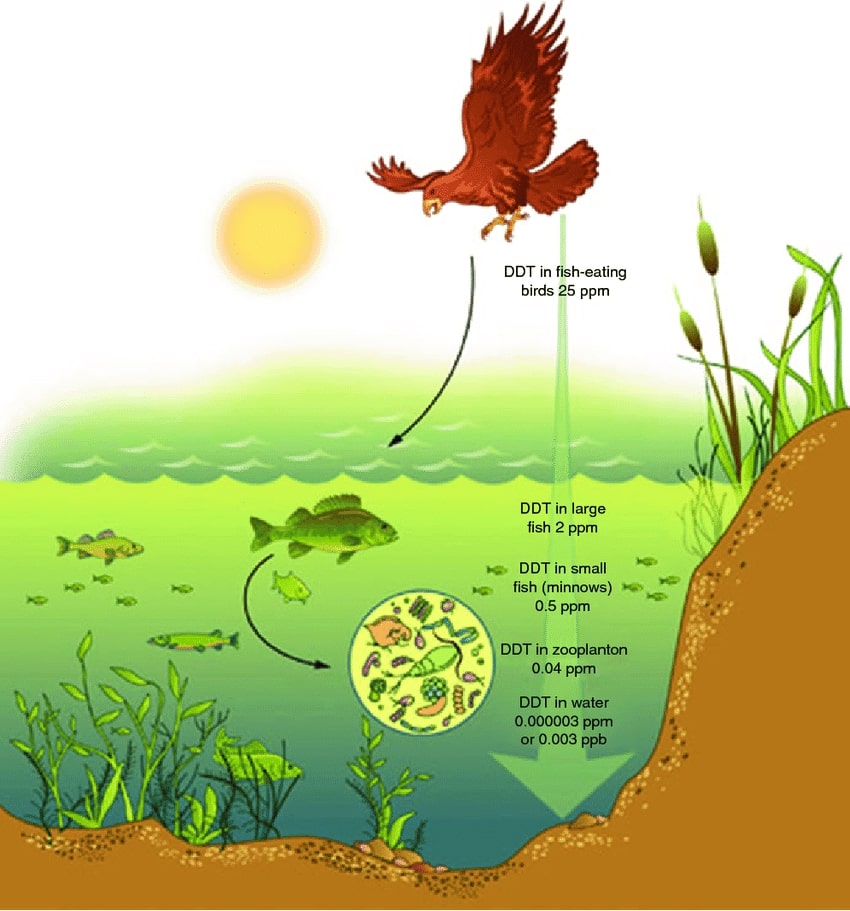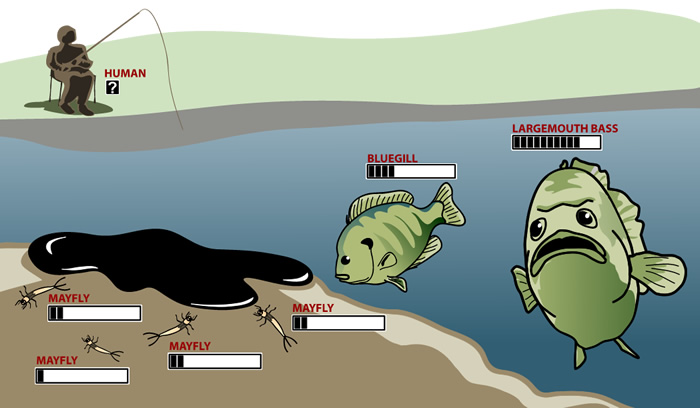Biomagnification is a process in which toxins such as pollutants or pesticides increase its concentration in the tissues of the organisms as it travels up in the food chain. For instance, fishes in the aquatic food chain contain more mercury than the one they eat. It is because they accumulate mercury more easily than they excrete it. This increase in the level of toxicity when moving up in the food chain is termed bioaccumulation. To know more about the term, read this post until the end.
Table of Contents
Biomagnification: An Overview
Biological magnification often depicts the process wherein pollutants and heavy metals make their way to the rivers, lakes, and oceans. Furthermore, they become a part of the food chain. Their concentration increases as we move up in the food chain. Some are water-insoluble, and some are hard to excrete, so the organisms at the top of the food chain contain a higher concentration of these pesticides and pollutants. Zooplanktons in the toxic lakes make fishes toxic when consumed by them. Now the fish is eaten by bigger fish, animals, or humans. These toxic or slowly digestible substances are known as bioaccumulation. They increase in concentration in living organisms as they take in contaminated air, water, or food.

Are Biomagnification And Bioaccumulation The Same?
People often feel it difficult to differentiate between the two terms; biomagnification and bioaccumulation. The two may sound the same. However, they are completely different.
Bioaccumulation
When an animal eats DDT-contaminated food, the DDT builds up in the animal’s tissue through a mechanism known as bioaccumulation. You can understand it as the primary stage of biomagnification.
Biomagnification
When moving up in the food chain, larger animals eat smaller ones who have accumulated the toxins in their body. The higher an animal (land or aquatic) is on the food chain, the greater will be the concentration of DDT in their body. This increase in the amount of DDT when moving up in the food chain is known as biomagnification.
Apparent Reasons Behind The Biomagnification
Below are some of the primary reasons that can give rise to biomagnification:
- Persistence: It is the condition when particles cannot be broken down by natural processes.
- Food Chain Energetics: It is where the level of the pollutants or toxins increases as we go up the food chain levels.
- Lower rates of internal disintegration or the non-solubility of the toxins can reduce the excretion as compared to the intake of the pollutants.
List Of The Main Bioaccumulators
Below are some bio accumulators that can increase bioaccumulation in the land and aquatic animals:
1: Lipids
If an organism lacks enzymes to dissolve lipid (lipophilic), or fat-soluble compounds, they cannot be diluted, broken down, or excreted in the urine, a water-based medium, and therefore accumulate in fatty tissues.
Fats are consumed in the intestine when ingested by another creature, carrying the material, which then accumulates in the predator’s fats. Since energy is lost at any stage of the food chain, a predator must eat a large number of prey, including all of their lipophilic substances.
2: Dichloro-Diphenyl-Trichloroethane (DDT)
DDT is one of the foremost reasons behind the biomagnification. EPA and other organizations consider it harmful and biomagnification is one of the foremost significant reasons for the same. It is stored within the fat of animals and takes a few years to interrupt down, and because the fat is consumed by predators, the amounts of DDT biomagnify. However, DDT is now a banned material in many parts of the planet.
Factors that will Increase The Bioaccumulators Inorganic phenomenon
Below are a couple of primary reasons which will promote the bio accumulators taken by the organisms during a food chain:
Agriculture
Agricultural insecticides, pesticides, fertilizers and fungicides are very harmful. These toxic materials are released into the soil, lakes, rivers, and seas. These agricultural waste materials contain small amounts of heavy metals like mercury, copper, arsenic, cadmium and lead. These cause health issues in both land and aquatic organisms.
Organic Contaminants
Industrially treated manures and biosolids include toxins such as pharmaceuticals and personal care products. Humans, livestock, and wildlife all suffer from the effects of these substances.
Industrial Activities
Factories and industries release toxic compounds into the soil, lake, seas, and rivers in the first place. Pollution from gaseous emissions pollutes the atmosphere, causing biomagnification of organic phenomena.
Mining Activities within the Ocean
Mining activities are administered within the deep sea to extract metal like zinc, aluminium, cobalt, silver and gold. The mining process generates an outsized amount of selenium and sulphide, which deposits in water and destroys the oceans and coastal regions. It increases the extent of toxicity. These toxic substances are eaten by the aquatic organisms higher within the organic phenomenon.
Effects of Biomagnification
Following are the consequences of biomagnification on living organisms and, therefore, the environment:
Impact on Human Health
Biomagnification makes humans more susceptible to cancer, kidney problems, birth defects, liver failure, heart diseases, and respiratory disorders.
Effects on Reproduction and Development of Marine Creatures
The toxic chemicals accumulate within the important organs of aquatic organisms that affect their reproduction and development processes. For instance, the shells of the eggs of the sea-birds are very thin, and birds destroy them during their incubation period. Toxic chemicals, such as mercury and selenium, destroy the reproductive organs of aquatic creatures.
Destruction of Coral Reefs
Cyanide that’s utilized in leaching gold and fishing is the main explanation for the vanishing of coral reefs. Coral reefs are the dwelling and feeding sources for several sea creatures. Their destruction affects the lives of many aquatic animals.
Disruption of organic phenomenon
The chemical wastes and toxins that industries release into the water bodies disrupt the organic phenomenon. The tiny organisms absorb the toxins and larger animal consume them later. It is how the accumulation of toxins takes place at a higher level of organisms.
How To Prevent Biomagnification?
Biomagnification is a serious threat to a healthy ecosystem. To reduce it, you can consider the below-given points:
- Avoid throwing harmful substances in water. You can reach out to a recycling centre for the safe disposal of these products.
- Don’t use chemical pesticides.
- Wash vegetables and fruits properly before eating them. If possible, eat certified organic food.
- Your cleaning products should be gentle to the environment.
- If you are spending time fishing near a contaminated area, don’t do it.
- Stop the use of plastic.
Final Words!
This post can help you to understand the term biomagnification and other essential aspects related to it. If you want to get more from us, then visiting our blog section can help.






Comments are closed for this post.